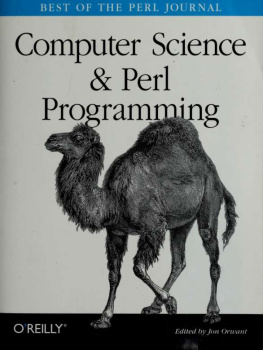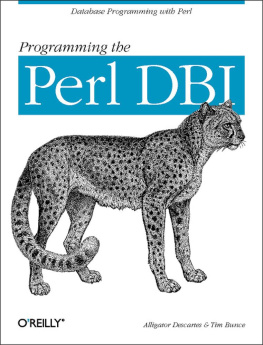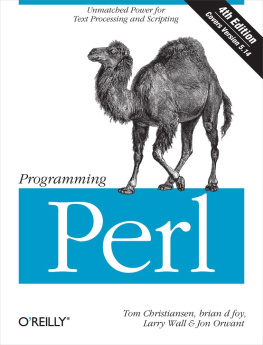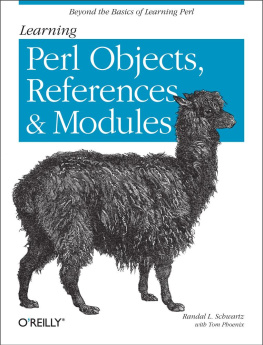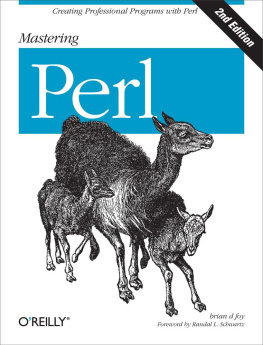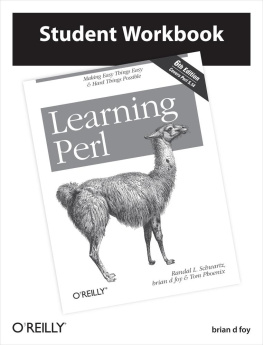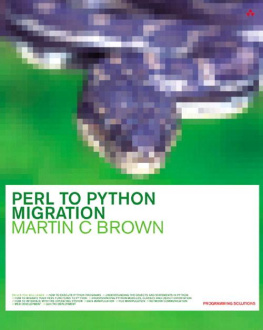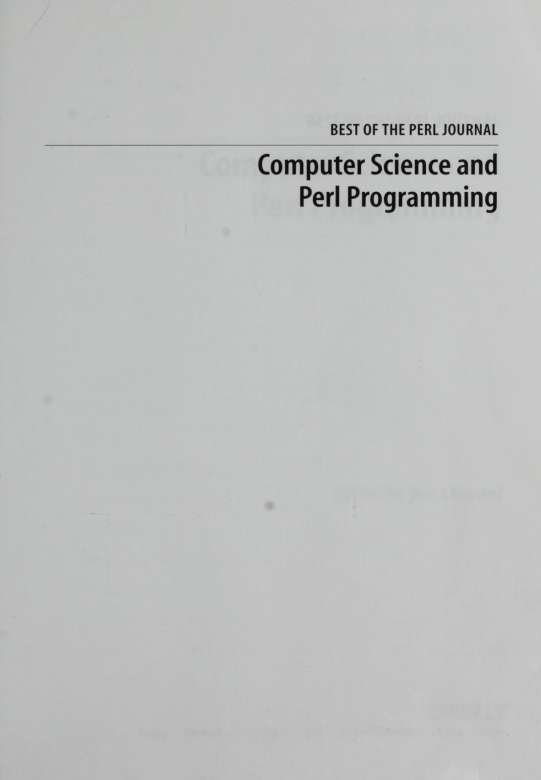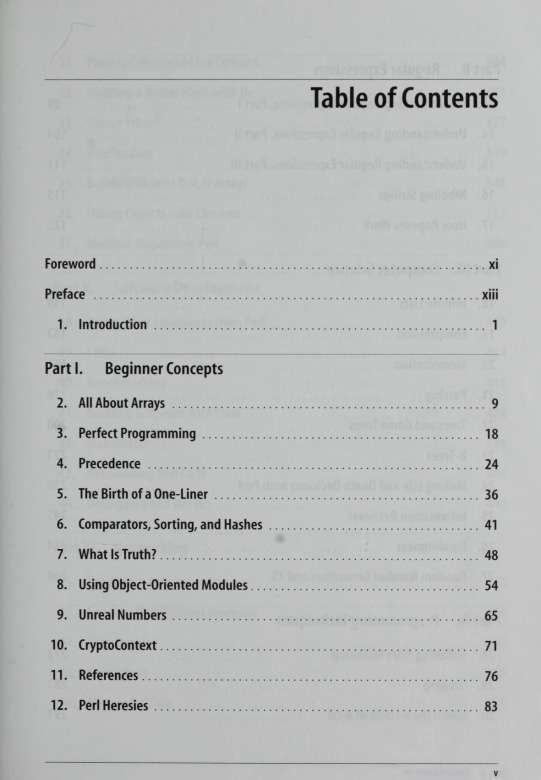This book made available by the Internet Archive.
Part II. Regular Expressions
13. Understanding Regular Expressions, Part I 89
14. Understanding Regular Expressions, Part II 104
15. Understanding Regular Expressions, Part III Ill
16. Nibbling Strings 115
17. How Regexes Work 122
Part III. Computer Science
18. Infinite Lists 139
19. Compression 152
20. Memoization 161
21. Parsing 176
22. Trees and Game Trees 200
23. B-Trees 221
24. Making Life and Death Decisions with Perl 238
25. Information Retrieval 245
26. Randomness 254
27. Random Number Generators and XS 260
Part IV. Programming Techniques
28. Suffering from Buffering 273
29. Scoping 281
30. Seven Useful Uses of local 291
32. Building a Better Hash with tie 311
33. Source Filters 327
34. Overloading 339
35. Building Objects Out of Arrays 348
36. Hiding Objects with Closures 355
37. Multiple Dispatch in Perl 366
Part V. Software Development
38. Using Other Languages from Perl 389
39. SWIG 404
40. Benchmarking 418
41. Building Software with Cons 424
42. MakeMaker 435
43. Autoloading Perl Code 443
44. Debugging and Devel:: 448
Part VI. Networking
45. Email with Attachments 455
46. Sending Mail Without sendmail 464
47. Filtering Mail 472
48. Net::Telnet 480
49. Microsoft Office 485
Table of Contents vii
51. Managing Streaming Audio 507
52. A 74-Line IP Telephone 518
53. Controlling Modems 531
54. Using Usenet from Perl 541
55. Transferring Files with FTP 547
56. Spidering an FTP Site 557
57. DNS Updates with Perl 570
Part VII. Databases
58. DBI 579
59. Using DBI with Microsoft Access 587
60. DBI Caveats 595
61. Beyond Hardcoded Database Applications with DBIx::Recordset 601
62. Win32::0DBC 608
63. Net::LDAP 622
64. Web Databases the Genome Project Way 637
65. Spreadsheet::WriteExcel 656
Part VIM. Internals
66. How to Improve Perl 671
67. Components of the Perl Distribution 676
68. Basic Perl Anatomy 679
69. Lexical Analysis 685
viii Table of Contents
71. Microperl 705
Index 711
About the Authors 731
Table of Contents ix
Foreword
Mark Jason Dominus
It's flattering that Jon Orwant invited me to write the foreword for this book. After all, the title is "Computer Science and Perl Programming," and that pretty much covers it all: "Programming" is anything with any practical relevance, and "Computer Science" neatly includes everything else. You folks haven't seen the Table of Contents for the second and third Best of TPJ books yet, but I have. Take my word for it, they're concerned with "Computer Science and Programming" also.
Why did I get this job? Partly because I've written more articles for TPJ than anyone else, unless you count Chris Nandor's "Perl News" columns. But I think it's also because I got a reputation for writing articles about "Computer Science and Programming," at least as much as anyone except perhaps Damian Conway. And Damian's too busy to write forewords, whereas I'm unemployed.
Perhaps I should say something about what you'll find in this book. The theory is that the casual browser standing in the bookstore might flip to the foreword to find out what the book is about. It's a rotten theory, because hardly anyone reads the foreword even after they've bought the book. More likely, you are a reviewer, hoping for some guidance about what to say in the review. Hello, reviewer! I am happy to assist.
This book is indeed the "Best of the Perl Journal," biased though my opinion might be by the inclusion of ten of my own articles. It does not suffer from the usual flaw of the anthology, which is that the best you can hope for is that more than half of the articles are above average. On the contrary, it is by turns brilliant, witty, and profound. (Please be sure to say so in the review, and be sure that nothing could ever induce me to exaggerate the merits of this volume. No, not even the hope of an increased royalty.)
The book begins, aptly enough, with a selection of articles for beginners. (Jon used to complain that not enough people wanted to write these: "All the clueful writers want to write about stuff that displays their cluefulness," he once told me.) The following section is about regexes, and the notable feature is the series of articles by Jeffrey Friedl on understanding regular expressions. These came along very early in the magazine's history, and were a major contributor to its success, since they were important articles by a Famous Person.
The third section is the "Computer Science" section. Most of the articles in that section turn out to be more practical than you would thinkPerl programmers have a wonderful way of making everything useful and of cannibalizing the most abstruse theory. I suppose cannibalization becomes a habit after a while.
Section 4 is titled "Perl Programming Techniques," a mixed bag of subsystems (source filters and operator overloading), alternative approaches to OOP (using arrays or closures instead of hashes), and miscellany (my attempt to summarize Perl's grotesque namespace semantics, which migrated here from the "Beginners" section, and the article I wrote as a followup when the tech editors complained about my advice in the first article.) Section 5 is another mixed bag, this one loosely about tools that support development: benchmarking and configuration utilities, for example.
Sections 6, 7, and 8, on networking, databases and internals, respectively, are more homogeneous. Note that the "Networking" section covers almost every important network application except the Web; those articles will be in the second Best of the Perl Journal book, title Web, Graphics & Perl/Tk. The section on databases includes an early article on Perl's ubiquitous DBI. The "Internals" section collects the excellent Guts series by Chip Salzenberg.
All together, there are 71 of the best articles I can remember from the magazine. The only important omission is that there's no article by Larry Wall; for that you'll have to wait until the third book.
Now a personal note: In revising my articles for this book, I built a little tool to compute the word-by-word differences between my own master copies and the versions Jon Orwant provided that were to go into the book. I didn't expect many changes, because Jon had told me in the past that my articles required very little editing. I always believed that my articles went into the magazine almost exactly as I had written them. But when I saw the results of the automatic comparison, I was rather dismayed. I understood at last how often Jon had tightened my phrasing, cleaned up my rhetoric, and eradicated my verbal tics. (The original draft of this foreword began with the words "It's pretty- flattering;" if it begins with anything else now, you will know that Jon has picked up after me again.) Not only did he do this with such a light touch that I was unaware of it until now, but he was willing to spare my vanity and let me take the credit for his work. So there you have it: Jon Orwant is not only a fine writer and an acute editor, but also a kind, kind man. He is the author of only one of the articles here, but it's nevertheless his book more than anyone else's.

